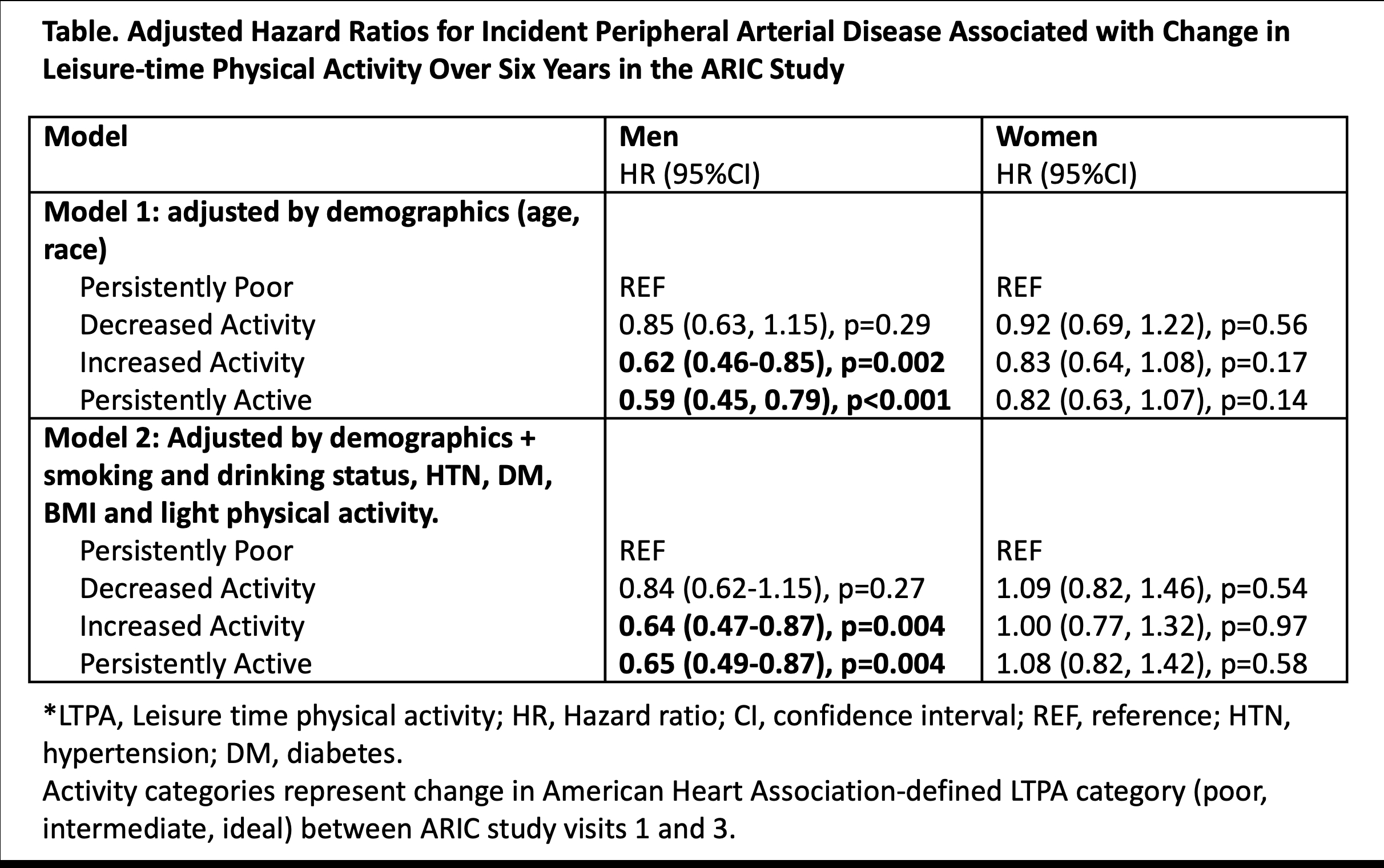Final ID: Su3075
Sex Differences in the Association of Leisure Time Physical Activity and Incident Peripheral Artery Disease
Abstract Body (Do not enter title and authors here): Background:
The benefit of leisure time physical activity (LTPA) in preventing peripheral artery disease (PAD) is well established. However, no prior studies have examined how longitudinal changes in LTPA during mid-life influence the risk of future PAD in men and women.
Methods:
We included participants from the Atherosclerosis Risk in Communities (ARIC) study who attended visit 3 and were free of PAD [ankle brachial index (ABI) >0.90] with available ABI during follow-up (measured ~5, 18, and 25 years after visit 3). LTPA was assessed using the modified Baecke questionnaire and defined as ideal, intermediate, or poor by the American Heart Association. Change in LTPA from visit 1 (1987-1989) to 3 (1993-1995) was subcategorized as 1) persistently poor, 2) decreased, 3) increased, or 4) persistently active. The primary outcome of time-to-incident PAD after visit 3 (ABI ≤ 0.90), was assessed using Cox models adjusted for relevant covariates.
Results:
A total of 8,421 participants were included (mean age 59 ± 5.5 years, 56% women, 20% Black). From visit 1 to 3, 1,609 participants had persistently poor LTPA, 1,860 decreased their activity, 2,015 increased their activity, and 2,937 remained persistently active. During a median follow-up of 17.7 years, 853 ARIC participants developed PAD (471 women and 382 men). An increasing or persistently active level of LTPA was associated with lower risk of incident PAD (HR 0.74 (0.60, 0.89) p=0.003 and HR 0.71 (0.58, 0.85) p<0.001 respectively) compared to persistently poor LTPA. There was no difference between those in the decreasing LTPA category and those with persistently poor LTPA (HR 0.88 (0.72, 1.09) p=0.24). There were no interactions with race, age, or body mass index; however, there was significant effect modification by sex (p-int 0.01). Men who increased activity or were persistently active had lower risk of developing PAD as compared to those with persistently poor LTPA (Table). There was no association between changes in LTPA and incident PAD in women.
Conclusions:
Maintaining or increasing LTPA over six years was associated with decreased risk of incident PAD in men but not in women. Further research is needed to clarify sex differences in these associations.
The benefit of leisure time physical activity (LTPA) in preventing peripheral artery disease (PAD) is well established. However, no prior studies have examined how longitudinal changes in LTPA during mid-life influence the risk of future PAD in men and women.
Methods:
We included participants from the Atherosclerosis Risk in Communities (ARIC) study who attended visit 3 and were free of PAD [ankle brachial index (ABI) >0.90] with available ABI during follow-up (measured ~5, 18, and 25 years after visit 3). LTPA was assessed using the modified Baecke questionnaire and defined as ideal, intermediate, or poor by the American Heart Association. Change in LTPA from visit 1 (1987-1989) to 3 (1993-1995) was subcategorized as 1) persistently poor, 2) decreased, 3) increased, or 4) persistently active. The primary outcome of time-to-incident PAD after visit 3 (ABI ≤ 0.90), was assessed using Cox models adjusted for relevant covariates.
Results:
A total of 8,421 participants were included (mean age 59 ± 5.5 years, 56% women, 20% Black). From visit 1 to 3, 1,609 participants had persistently poor LTPA, 1,860 decreased their activity, 2,015 increased their activity, and 2,937 remained persistently active. During a median follow-up of 17.7 years, 853 ARIC participants developed PAD (471 women and 382 men). An increasing or persistently active level of LTPA was associated with lower risk of incident PAD (HR 0.74 (0.60, 0.89) p=0.003 and HR 0.71 (0.58, 0.85) p<0.001 respectively) compared to persistently poor LTPA. There was no difference between those in the decreasing LTPA category and those with persistently poor LTPA (HR 0.88 (0.72, 1.09) p=0.24). There were no interactions with race, age, or body mass index; however, there was significant effect modification by sex (p-int 0.01). Men who increased activity or were persistently active had lower risk of developing PAD as compared to those with persistently poor LTPA (Table). There was no association between changes in LTPA and incident PAD in women.
Conclusions:
Maintaining or increasing LTPA over six years was associated with decreased risk of incident PAD in men but not in women. Further research is needed to clarify sex differences in these associations.
More abstracts on this topic:
Angiotensin Converting Enzyme Gene Polymorphisms (ACE-I/D) Do Not Predict Exercise-Induced Cardiac Remodeling or Performance in Adolescent Male Athletes
Becker Kristian, Hardie William, Gubanich Paul, Hill Garick, Logan Kelsey, Martin Lisa, Powell Adam
A 60-fold increase in SCA risk in the last kilometer of endurance races : Final sprint, fatal outcome.Chocron Richard, Levy Bernard, Beganton Franckie, Bougouin Wulfran, Empana Jean-philippe, Jouven Xavier, Laurenceau Thomas, Chabrol Marion, Mignot Soline, Meli Ugo, Langlois Camille, Cezard Pierre, Schwartz Peter, Kaab Stefan

